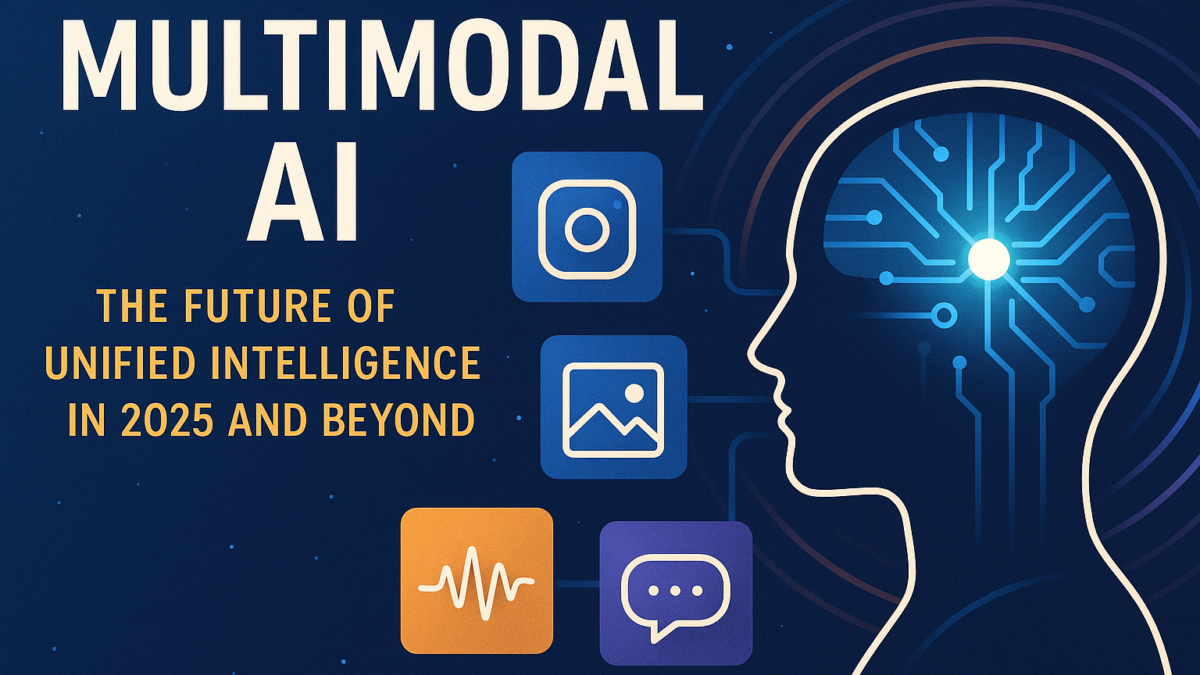
Multimodal AI: The Future of Unified Intelligence in 2025 and Beyond
Artificial intelligence (AI) is no longer limited to processing just text or images—it’s becoming multimodal, meaning it can now understand and generate outputs across text, image, audio, and video simultaneously. This powerful evolution is known as Multimodal AI, and it’s one of the biggest technological revolutions in 2025.
The impact of unified intelligence across different modalities is already evident, whether you’re utilising Google Gemini 1.5, Sora-generated video content, or OpenAI’s GPT-4o. Let’s examine multimodal artificial intelligence (AI), its significance, its future, and how it is changing a variety of sectors, including healthcare, education, and entertainment.
What is Multimodal AI?
Multimodal AI refers to systems that can simultaneously process and understand multiple types of data—such as:
- Text (like a chatbot or document),
- Images (like a photo or diagram),
- Audio (like voice or sound cues), and
- Video (like a clip or surveillance footage).
Multimodal systems integrate data from several sources to produce more human-like responses, improve predictions, and comprehend the environment more as a human would, in contrast to traditional models that only use one kind of input.
Why Multimodal AI Matters in 2025
In 2025, people utilise speech, gestures, video calls, and multimedia material to engage with technology; the internet is no longer solely text-based. A model that is only text-based is unable to comprehend the entire context of a user. Multimodal AI becomes essential in this situation.
Real-world impact:
Healthcare: Multimodal AI helps interpret X-rays, doctor notes, and patient interviews to make accurate diagnoses.
Education: AI tutors can now understand a student’s spoken question, analyze their uploaded homework image, and respond with an animated explanation.
Entertainment: Text-to-video models like Sora allow users to generate entire video scenes from a sentence.
Top Tools and Models Leading the Multimodal Shift
GPT-4o by OpenAI:
OpenAI’s GPT-4o is one of the most advanced multimodal models available, allowing seamless interaction across text, voice, images, and video. It can:
- Watch a video and describe what’s happening,
- Answer questions about a photo,
- Carry on a voice conversation with contextual understanding.
Sora AI:
Sora by OpenAI turns text prompts into short videos—a leap forward in AI-powered content creation for filmmakers, educators, and marketers.
Google Gemini:
Gemini 1.5 is another major player in multimodal AI. It focuses on deep integration between search, video, coding, and educational tools—redefining productivity and knowledge consumption.
Applications of Multimodal AI in Real Life:
1. Education
- AI tutors that see your homework and hear your confusion.
- Automatic summarization of lecture videos.
- Interactive learning modules built from textbooks, videos, and audio clips.
2. Healthcare
- Combining image scans, patient records, and spoken symptoms for more reliable diagnostics.
- AI chatbots that understand tone and urgency in patient voices.
3. Content Creation
- Text-to-video storytelling.
- AI designers who take voice input and generate website designs.
- Podcast generation using voice cloning + script writing.
4. Accessibility
- Real-time captioning, translation, and emotion-aware assistants for users with disabilities.
- Smart glasses that describe surroundings for visually impaired users.
Challenges of Multimodal AI
While promising, multimodal AI still faces several hurdles:
- Ethical Concerns: Deepfakes, misinformation, and identity theft can be supercharged by multimodal tech.
- Data Processing: Handling multiple formats simultaneously requires massive computing power and optimized architecture.
- Model Alignment: Teaching the AI to align meaning across modalities (e.g., matching a spoken command to a relevant image) is complex.
What’s Next? The Future of Unified Intelligence
2025 is just the beginning. Soon, we’ll interact with AI in fully immersive ways—through AR glasses, VR experiences, and AI agents that remember our preferences, respond emotionally, and act autonomously across tasks.
Multimodal AI will power:
- Autonomous cars that see and hear their environment.
- Virtual therapists who detect emotions through tone and facial expressions.
- AI teachers that personalize lessons based on voice, writing, and gestures.
Conclusion
Multimodal AI is the foundation of next-generation intelligent systems, not just another catchphrase. A future where AI comprehends us more easily, communicates with us more effectively, and gives us greater power is being shaped by the development of models like GPT-4o and Gemini.
The goal of unified intelligence in this new century is to improve human creation, communication, and teamwork, not to replace us.